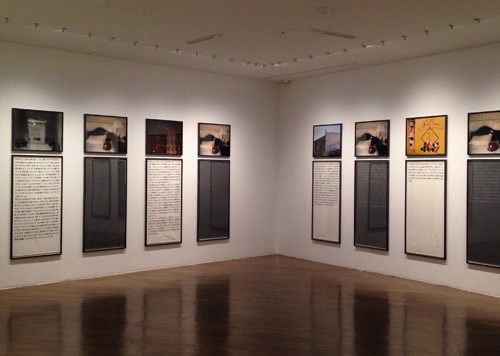
Sophie Calle, Exquisite Pain (1999)
Installation view from Trace: Selections from the Hara Museum Collection
The current exhibition at the Hara Museum of Contemporary Art, Hara Documents 10: Masaharu Sato – Tokyo Trace (Galleries I and II), features video installations by Masaharu Sato who has developed a unique form of animation based on tracings of actual video footage. After shooting ordinary scenes of people or landscapes, Sato transfers the video to a computer. Then, using a software pen and an immense amount of time and labor, traces the images, laying down one line after another in an attempt to get as close to the video image as possible.
Concurrent Exhibition: Trace: Selections from the Hara Museum Collection
This concurrent exhibition, presented in Galleries III, IV and V on the second floor, features works selected from the Hara Museum Collection on the theme of “trace,” which echoes the technique used by Masaharu Sato. Introduced below is a work featured in this show, Exquisite Pain (1999) by Sophie Calle, one of the most celebrated contemporary artists of France.
What is Exquisite Pain?
The expression “exquisite pain” refers to a medical condition in which a part of the body is affected by a sharp, acute pain or suffering. Using photographs and texts, Calle has turned the pain of her own experience of lost love and her subsequent recovery into a work of art that she calls Exquisite Pain. Part 1 recounts the days leading up to the worst day of her life through photographs and texts that she sent to her lover.
This exhibition shows only Part 2 which shows her recovery as she repeats her story of unhappiness to others and listens to their stories in return. In this work, Calle bares her personal life and turns to the lives of others. On the other hand, the work is suffused with an ambiguity that draws no clear distinction between fact and fiction. The Japanese version of this work was first produced 1999 for an exhibition at the Hara Museum. It was followed by French and English versions that have appeared throughout the world.
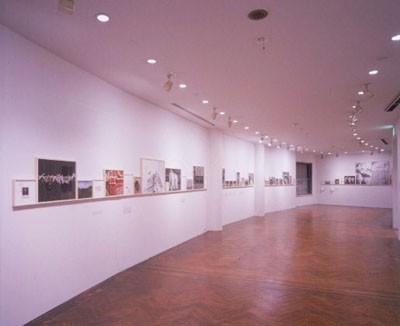
Installation view from Sophie Calle: Douleur Exquise (first part) at the Hara Museum in 1999
Who Is Sophie Calle?
Born in Paris in 1953, Sophie Calle is a contemporary artist who has earned fame for her highly narrative work composed of photographs and language. For the project The Sleepers (1979), Calle photographed and interviewed 24 strangers whom she had invited to come to her home and sleep in her bed. For Hotel (1981), Calle worked as a chambermaid at a hotel in Venice where she photographed the rooms of the hotel guests. Address Book (1983) refers to an address book found by the artist. Calling the people listed in the book, Calle conducted interviews about the owner and then published them in the French daily newspaper Libération.
These projects, including those made during the 1990s such as True Stories and Suite Venitienne, were intriguing mixtures of fact and fiction. During this time, she also began working on a series about persons without sight, beginning with The Blind (1986). It was a profound examination into the nature of sight and perception, which lie at the very foundation of art. Calle’s activities as a filmmaker and other aspects of her lifestyle inspired the author Paul Auster to use her as the model for a fictional character named Maria Turner in his novel Leviathan. Calle in turn assumed the personae of Maria Turner in a work she created called Double Game (1998). These pieces, which transcended the boundaries of contemporary art, remain a focus of much attention today.
Following Exquisite Pain, Calle returned to the Hara Museum in 2013 with the exhibition Sophie Calle, For the Last and First Time. This show later traveled to the Toyota Municipal Museum of Art (2015) and is presently being shown at the Nagasaki Prefectural Art Museum (until March 21, 2016).
Douleur exquise (French version) now available at the Museum Shop
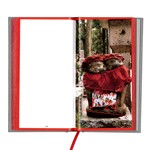
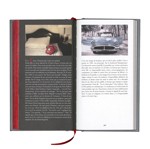
Douleur exquise (Published in 2003) 4,320 yen (tax included)
This French-language volume exquisitely conveys the feeling of “exquisite pain” through tales of heartbreak, lost sight and other personal tragedies. Hardcover, 281 color pages.
※Comes with a Japanese translation supplement provided by the Hara Museum (covering selected passages).
Exquisite Pain Tidbits
1) Exquisite Pain’s World Debut at the Hara Museum
The impetus behind the creation of Exquisite Pain was Calle’s journey to Japan to assume a residency. It was thus her desire to have the world premiere of the work in Japan. Contact was made with the Hara Museum towards that end and the exhibition was realized there as she had hoped. In creating the show, the size and proportions of all works that comprise Parts 1 and 2 were determined on the basis of the Hara Museum’s wall space. In the later French version, a more vertically elongated space was used for the text. Such detailed adjustments to suit the exhibition space are indicative of Calle’s rare aesthetic sensibilities.
2) French-language Version
The French version of this work, Douleur Exquise, was added to the Hara Museum Collection after it appeared in Sophie Calle’s major retrospective at the Pompidou Center in 2003-2004.
3) Text Embroidering in Niigata
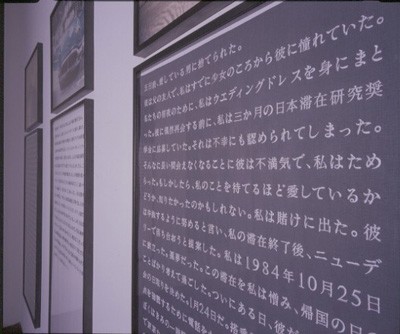
One defining feature of Part 2 of Exquisite Pain is the use of embroidery for every text that appears in the work. Having received word from Calle that she had found an experienced embroiderer in France capable of recreating the sample exactly, the initial plan was to have the Japanese text hand-embroidered in France. The volume of texts involved was, however, huge. It was then the museum had a fortuitous encounter with someone from an embroidering factory in Niigata, Thanks to their tremendous cooperation, the huge task of embroidering was completed by way of machines designed to handle the Japanese language. The linen cloth used was specially selected by the artist and delivered from Belgium. So happy was Calle with the results that she had the French-language version embroidered in Niigata also.
4) Specially Commissioned Translation
It might be said that the heart of Sophie Calle’s work is the text. To create a translation with all the nuances of the original, the copywriter Momoko Takeuchi was asked to produce this vital text for the Japanese version.
5) Memorabilia Turned Into Subject Matter in Part 1
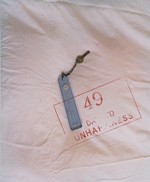
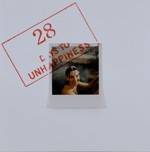
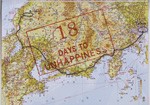
These items comprise memorabilia that had been sealed for 15 years: handwritten notes, map, Polaroids, contact prints, paper money (Chinese) and a certain hotel key that shouldn’t be there. (These items are not on display.)
6) Participation of Philosophers and Artists
Included in the people who exchanged their most painful experience with Calle in Part 2 were philosophers and artists, one of them being Jean-Michel Othoniel, an artist who held a solo exhibition at the Hara Museum.
——————————————————————
Trace: Selections from the Hara Museum Collection
Venue: Hara Museum of Contemporary Art (Galleies III, IV and V)
Organized by: Hara Museum of Contemporary Art
Featured Works:
Tomoko Yoneda, Trotsky’s Glasses – Viewing a dictionary that was damaged in the first assassination attempt on his life, 2003
120 x 120 cm gelatin silver print
Bernd & Hilla Becher, 4 Chevalements, 1989
57.1 x 47.4 cm each (group of 4 works) gelatin silver print
Jason Teraoka, Neighbor, 2006
20 x 16 cm (group of 88 works) acrylic, Ink, and glue on paper
Cindy Sherman, Untitled Film Still, 1978
21 x 26 cm photograph
Cindy Sherman, Untitled Film Still, 1980
26 x 21 cm photograph
Yasumasa Morimura, Beyond Ordeal by Roses “The Sound of the Waves Whispers in My Ear” 2006
48 x 58 cm gelatin silver print
Sophie Calle, Exquisite Pain (second part)
1999
